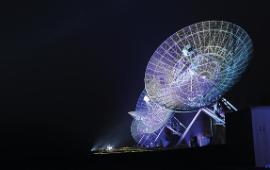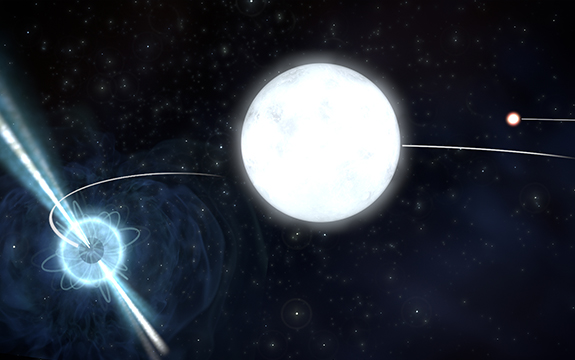Swinburne astronomer helps test Einstein’s theory of general relativity

In Summary
- Swinburne astronomer helps to show Einstein’s theory still can’t be proven wrong
- The discovery of a unique star system allowed this test to be carried out
- The results of this test severely constrain a range of competing theories on gravity
A Swinburne researcher has helped test Einstein’s theory of general relativity and shown it still can’t be proven wrong, using the complicated orbital dance of three compact stars.
Einstein’s strong equivalence principle says all objects should fall the same way in a gravitational field, regardless of their composition or how dense they are.
The triple stellar system was discovered in 2012 and was determined to be the perfect system to test the theory due to the substantial differences in the make-up of the three stars.
Swinburne’s Dr Adam Deller was part of a team of nine astronomers in this worldwide research collaboration.
After five years of intensive observation of the system, the team was able to conclude that the theory of general relativity is still relevant, as seen in the research paper published in the prestigious international science journal, Nature.
“This particular system consists of one ultra-dense neutron star and two less-dense white dwarf stars, which makes these stars the dream team for testing relativity,” Dr Deller says.

The pulsar and the inner white dwarf are in a 1.6-day orbit. This pair is in a 327-day orbit with the outer white dwarf, much further away. | Credit: The SKA Organisation.
Making the whole test possible was the fact that the neutron star can be observed as a radio pulsar, meaning the bright beam of electromagnetic radiation that it emits can be detected from Earth.
“The radio pulsar star acts like a clock in the sky. It spins in a very predictable way and each time it sweeps past the Earth we see a little blip of radio emission, which we can treat like the ticks of a clock.”
According to Dr Anne Archibald, the principal author of the paper from the University of Amsterdam and the Netherlands Institute for Radio Astronomy, the researchers can account for every single pulse of the neutron star since they began the observations.
“We can tell its location to within a few hundred metres. That is a really precise track of where the neutron star has been and where it is going,” Dr Archibald says.
This precise measurement of the pulsar’s location is the tool used to test the strong equivalence principle.
“By tracking the motion of the pulsar via pulsar timing, we can tell whether it, and its nearby less dense companion, are both falling towards the third and more distant star in the same way as general relativity predicts, and we couldn’t detect any difference,” Dr Deller says.
Implications of these findings
Since Einstein came up with the theory of general relativity, scientists have tried to come up with a better, alternative explanation for how gravity works. A whole range of these competing theories have been severely constrained by the findings of this test.
“The theory of general relativity has fixed parameters that can’t be changed, whereas other theories of gravity have parameters whose values can change to keep them consistent with this result,’ Dr Deller says.
“The results of this research shrink the amount of wiggle room available to alternative theories of gravity.
“We still don’t know if general relativity is correct, but now we know that the right gravitational theory must look even more similar to general relativity that we previously thought.”
Dr Deller is a Senior Lecturer and ARC Future Fellow in Swinburne’s Centre for Astrophysics and Supercomputing and an Associate Investigator at the ARC Centre of Excellence in Gravitational Wave Discovery (OzGrav).
Read the full research paper, ‘Universality of free fall shown by orbital motion of a pulsar in a stellar triple system’, in Nature.

